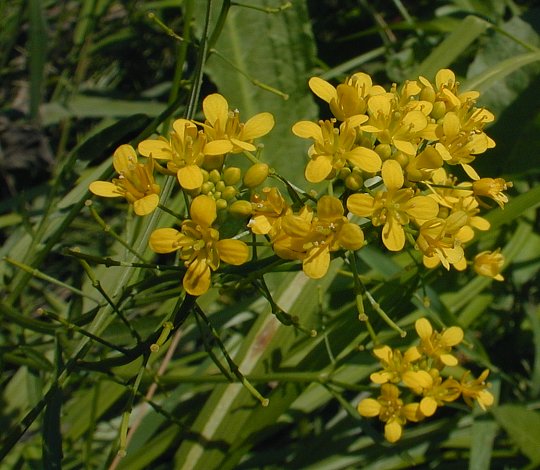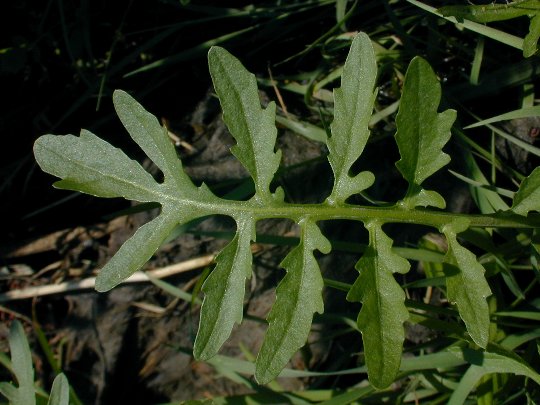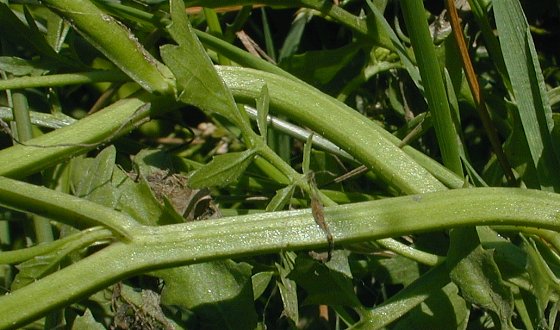Description: This herbaceous perennial plant is ½–2' long, branching occasionally in the upper half. The lower stem of this plant has a tendency to sprawl along the ground in the absence of supportive vegetative, otherwise it is more or less erect. Both the lower and upper stems are glabrous, angular, and somewhat succulent. The alternate leaves are up to 5" long and 2" across, becoming smaller as they ascend the stems. They are glabrous, pinnately lobed, and oblong-ovate or lanceolate-ovate in outline; the terminal lobe is often broader than the other lobes. The margins of these leaves are bluntly dentate, shallowly lobed, or undulate.

The upper stems
terminate in racemes of yellow flowers. These flowers bloom near the
apex of the raceme, while the siliques on spreading pedicels develop
below. Each flower is about 1/3" (8 mm.) across when fully open,
consisting of
4 yellow petals, 4 yellow green sepals, 6 stamens, and a pistil with a
stout style. The blooming period occurs from early to mid-summer and
lasts about 1½ months. Each flower is replaced by a slender silique
about ¼" long on a slender pedicel about 1/3" (8 mm.) long. Each
silique is
straight or slightly curved, terminating in a short beak; it contains
several tiny seeds that can probably float on water or blow about in
the wind. The root system produces abundant rhizomes and vegetative
offsets of the mother plant; sometimes a prostrate lower stem will form
rootlets near the leaf axils on moist ground. This plant often forms
colonies.
Cultivation:
The preference is full sunlight, wet to moist conditions, and a mucky
soil with abundant organic matter. Temporary flooding is tolerated,
although more or less permanent standing water is not. This plant
withstands occasional mowing.

Range &
Habitat:
The non-native Creeping Yellow Cress occurs occasionally in the
northern half and SE
Illinois, but it is rare or absent in SW and south-central areas of the
state (see Distribution
Map). Habitats are disturbed wetlands, including muddy or
grassy borders of ditches, soggy meadows in floodplain areas, and
poorly drained areas along railroads. Creeping Yellow Cress is
native to Eurasia.
Faunal Associations:
Little is known about this plant's relationships to various fauna. Like
other members of the Mustard family, the nectar and pollen of flowers
probably attract small bees, flower flies, and White butterflies. The
foliage may be eaten by the caterpillars of some White butterflies,
such as Pieris rapae (Cabbage White).
Photographic Location:
Along a drainage ditch in Champaign, Illinois, where large colonies of
this plant occurred.

Comments: Among the Rorippa spp. (Yellow Cresses) that occur in Illinois, this is the species with the showiest flowers. Unfortunately, Creeping Yellow Cress is not native to North America (according to most authorities), and it is somewhat aggressive in disturbed wetland areas. It remains to be seen if this species will invade higher quality wetlands (the few that remain within the state). It is fairly easy to distinguish Creeping Yellow Cress from other Yellow Cresses because it has the largest flowers (at least ¼" across). It also has widely spreading pedicels and siliques that are longer and more slender than other Yellow Cresses. Two common native species, Rorippa sessiliflora (Sessile-Flowered Yellow Cress) and Rorippa palustris (Marsh Yellow Cress), are larger plants with smaller flowers (less than ¼" across). The siliques of these latter two species are stouter and resemble little sausages. Unlike many other members of the Mustard family, the Yellow Cresses are largely restricted to wetland habitats.